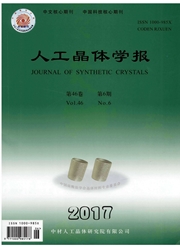

 中文摘要:
中文摘要:
当硅基发光材料得到广泛应用时,为了给硅基材料的设计及应用提供理论依据,利用基于密度泛函理论的第一性原理,对Er掺杂在Si纳米晶粒不同位置的结构稳定性、电子与光学性质进行了研究。结果表明:Er掺杂在Si纳米晶粒的中心位置时,结构最稳定;Er掺杂后的Si纳米晶粒引入了杂质能级,最终导致禁带宽度变窄;掺杂后的Si纳米晶粒在低能区出现了一个新的吸收峰,当Er原子向表面位置移动时,新的吸收峰峰值逐渐减小,甚至消失。
 英文摘要:
英文摘要:
When the silicon-based photoelectron material is widespread, the structural stability, electronic and optical properties of Er-doped silicon nanoparticles were investigated by first-principles based ondensity functional theory to provide the theory basis for the silicon-based material's design and application. The results show that the structure is more stable when the Er is in the central position. The doping of Er atom in silicon nanoparticle introduces the impurity levels, which result in the narrowing of band gap. A new absorption peak occurs in the low-energy region of Er-doped silicon nanoparticle, however, the value of the absorption peak decrease gradually, even disappear when the Er move to the surface.
 同期刊论文项目
同期刊论文项目
 同项目期刊论文
同项目期刊论文
 The elimination of deviations of the mean-field Landau-type theory from the fancy size effect experi
The elimination of deviations of the mean-field Landau-type theory from the fancy size effect experi The difference of energies of Si atoms with single-crystalline,amorphous,free and nanoparticle confi
The difference of energies of Si atoms with single-crystalline,amorphous,free and nanoparticle confi Dynamical transportation of Si particles produced by pusled laser ablation in the mixture of two ine
Dynamical transportation of Si particles produced by pusled laser ablation in the mixture of two ine 期刊信息
期刊信息
